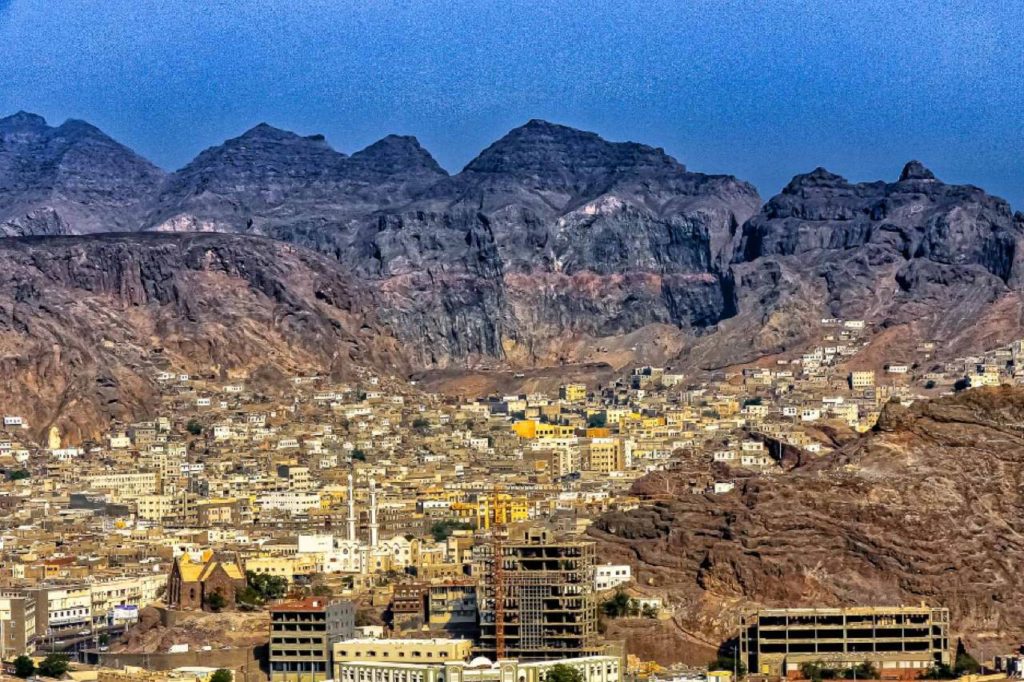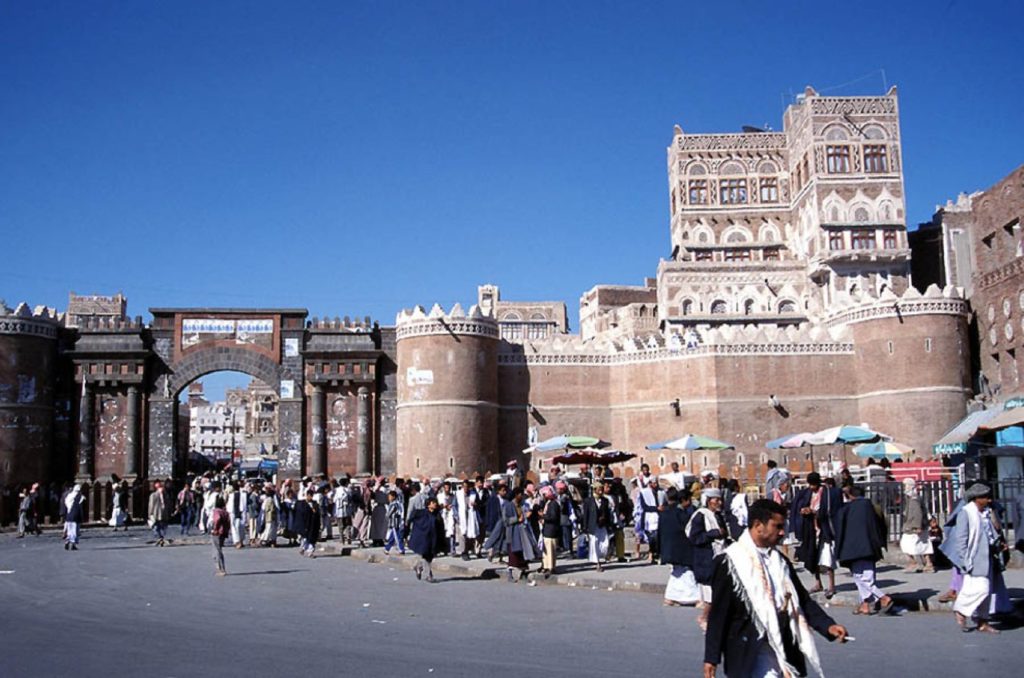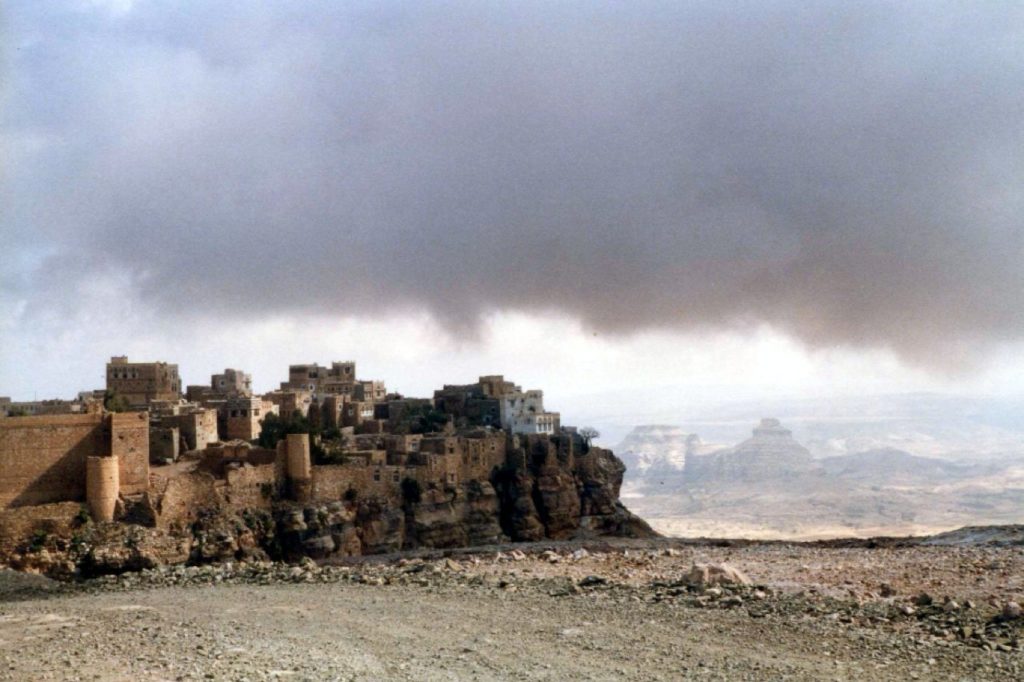Nothing can be imagined more beautiful than the scenery of the mountains of Yemen. Torn into all manner of fantastic peaks, the rocky crags add wildness to a view that otherwise possesses the most peaceful charms. Rich green valleys, well timbered in places, and threaded by silvery streams of dancing water; sloping fields, gay with crops and wildflowers; the terraced or jungle-covered slopes,—all are so luxuriant, so verdant, that one’s ideas as to the nature of Arabia are entirely upset. Well known as is, and always has been, the fertility of this region, its extent is almost startling. It can little be wondered at that Alexander the Great intended, after his conquest of India, to take up his abode in Yemen.
Aden is a city in the Yemeni Coastal Plains, on the Gulf of Aden just at the Southern End of the Red Sea. It is a UNESCO World Heritage Site. Aden has a long and complicated history.
Marco Polo described it as a hub of commerce, where goods arriving by ship from the East were transferred to smaller boats for the trip up the Red Sea and on to Alexandria and Christendom. At one point, it ruled a small empire, the part of Africa just across from it. In the 19th century, it became a British protectorate. It was the capital of South Yemen until Yemen was re-united in 1990.
It is a very picturesque city with a mix of traditional Arabic and British influences. It was the capital of the liberal South and is presently changing negatively due to the take-over of the tribal forces of the North. For instance, the Soviets banned headscarves for women, and for decades, women were relatively emancipated and could carry out university degrees abundantly.

Sana’a: Babel Yemen (old city), Wadi Dhar (Dar al-Hadschar Palace – also known as the rock house). Note that Sana’a is over 2,200m (7,200 feet) in elevation. The old city is a mystical and fantastic place and also a UNESCO World Heritage site. The streets are alive and bustling around gingerbread-like houses, several stories high, one of the oldest cities in the world.

Socotra: Off the south coast of Yemen – an idyllic island untouched by modern man and home to many rare species and plants. The seas are turquoise blue and the sands white and unspoiled. One of the most valuable islands on the planet is often described as the most alien-looking place on Earth. Its beaches resemble those of the Caribbean, and its mountains and Yemeni mountains are covered in 300 species only found in Socotra.
Kawkaban: An old fortress-city northwest of Sana’a 3,000m (10,000 feet) high, with elegant old buildings and artifacts from the old Himyar civilization 2,000 years ago. Himyaric inscriptions can be seen, and so can old Stars of David from the old Jewish roots of Himyar. Below the mountain is a magnificent view of a plain dotted by old towns made of mud-brick.

Sa’dah: The northernmost central town in Yemen, with its old city, made entirely out of stong mud that keeps internal temperature warm during the bitter winter. Its surroundings are known for its delicious grapes, raisins, date palms, and other fruits.
Al Mahweet: A northwest town from Sana’a, Al Mahweet is a beautiful and magnificent town atop a mountain where the green scenery and outstanding architectural example of Yemen are best. It is part of the western highlands, an area where rain can be extensive, and clouds can always be seen below the mountains during the summer.
Bura’: A protected area in Yemen in Al Hudaydah governs, this place is a 2,200 meter (7,200 foot) mountain covered by natural forests resembling one of the rainforests of Africa. There are many flora and fauna varieties in Bura’ located only in Yemen and its historic boundaries (Najran, Jizan, Asir, Dhofar, & ar Rub’ al Khali). It is one of the most beautiful places in Yemen.
Manakhah: A large old town on a peak 2,700m (9,000 feet) high known for its daring location and beautiful scenery. This town is a perfect example of life in medieval Yemen.
Ma’rib: The capital of the Sabaean Kingdom, built about 3,000 years ago, with its famous Ma’rib dam, one of the engineering wonders of the world. It was said that thousands of years ago, the magnificent dam helped create some of the greenest areas in the world, a notion also supported by historical texts like the Qur’an. The Queen of Sheba is known to have had her kingdom here, and artifacts and temples from her reign are still preserved and present.
Ibb: The green heartland of Yemen, with annual rainfall at about 1200 mm per year. It is located about some 3000 meters (10,000+ foot) high mountains. The city of Ibb, however, is in the valley, but waterfalls are known to be present and beautiful. The historic town of Jiblah is located near Ibb city. And with the freshest climate on the whole peninsula, there is no wonder why it is called the Green Heart of Yemen.
Al Khawkhah: At one of the hottest places on Earth, you need a beach, and at Al Khawkhah, it has one of the best beaches in Yemen. The shore is long and back by fields of palm trees and a small pleasant town. The Red Sea is relatively calm and cool, great for an holiday where summer temperatures are commonly over 48°C.
Ta’izz: The cultural capital of Yemen, which is the most liberal and the friendliest city in the country. It has been the capital of Yemen when the last Imam was in power and is a medieval city. Towering above Ta’izz is the 3,000m (10,000 foot) Jabal Sabir, which is known all around Yemen for its dazzling ascent and view from the top. This mountain is very fertile and is home to tens of thousands of people living on and around the mountain.
Shibam: commonly called the Manhattan of the Desert, this town located in Wadi Hadhramaut has the first skyscrapers of the world. Hundreds of adobe homes ranging from 5-11 stories high are boxed into a walled area that is simply marvelous. The tops are painted with gypsum, a mineral commonly found in Yemen. Some of the buildings are over 700 years old.
Tarim & Say’un: These nearby towns are made almost entirely of adobe. The towns are well organized and elegant, with famous palaces and mosques in each city.
Al Mukalla: Perhaps the most developed-looking city in Yemen, Al Mukalla, is the jewel of the Arabian Sea. Around it around beautiful beaches, however, the best in Yemen is known to be at Bir Ali, which is a lengthy 100 km drive, though very much well worth it.
Hauf National Park: The only natural forest in the Arabian Peninsula because it is affected by the seasonal monsoon rains that also affect India. Mountains and Hills are layered with a cap of green for a mile with wildlife similar to one of rain forests; this forest also extends to the Omani side of the border, from Qishn, Yemen to Salalah, Oman.
